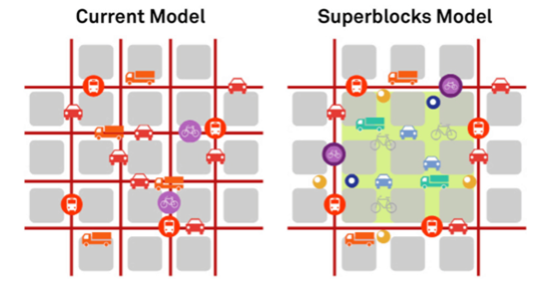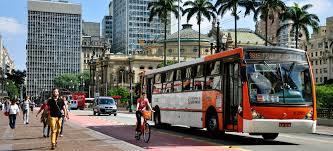Calls for sustainable mobility are made almost daily, but we see a strong focus on isolated solutions, often without taking into account the overarching development of cities. This is not enough, because the mobility of the future must be oriented to new concepts of urban development – and not vice versa. Only in this way will it be possible to take the citizens of a city along with them and offer them a continuous customer journey between life and mobility.
Introduction
Urban agglomerations are the center of social life for almost 75% 13wedof the population in many countries and at the same time the engine of the economy. Over 80% of the European Union’s gross domestic product is generated in cities. At the same time, a strongly increasing demand for mobility arises especially when living, working, education, utilities and leisure are separated from each other. Social participation, and often just normal life, depends heavily on individual mobility. We can see the consequences every day: Traffic jams, greenhouse gas emissions, air pollution, noise and safety risks.
So to meet societal needs, we need both technological approaches, smart city management, less traffic – and the consent of citizens:inside. More than one hundred years ago, Joseph Schumpeter wrote: “Innovation is not inventors inventing, but customers adopting. New approaches are only as good as their acceptance by the public.
And that’s where politics comes in: This is where all the threads often come together. Traffic planning and the will of the citizens, technological feasibility, the control of particular interests of individual stakeholders, and much more. When three out of four people live in these cities, mayors become presidents and urban planners become ministers.
Coordination of urban development and mobility
But this coordination function (not control function) is often missing. Countless start-ups are delighting us and the cities with great new solutions: E-bikes, E-scooters, E-cargoBikes, etc. for urban space – but without offering solutions as to where the space for all these new means of transport should come from. Here, often only the common good of public space (Tragedy of the Commons) is referred to. Automobile companies outbid each other in the production of new electric cars, which often (not always) have a positive effect on CO2 emissions, but do not need less space than, for example, diesel cars.
And in some cases even have the opposite effect: If, for environmental reasons, a small or mid-size car was previously driven, for many drivers this is now a good reason to switch to an electric SUV, thanks to subsidies. No more guilty conscience, but in the parking garage you suddenly need two parking spaces. Add to that more and more bicycles, which are increasingly demanding their own lane and thus their share of public space. Pop-up bike lanes can only be an interim solution. And then, at the very end, there was something else… oh yes, the pedestrian:in! The concepts for the implementation of the so-called WalkAbility of Cities (see e.g. approaches in HongKong), which have existed for a long time, hardly get off the ground. What is needed is an overarching approach that both develops new concepts for urban residential development and takes into account the consequences for mobility and for the people who depend on this mobility.
Current approaches
Citizens’ approval of traffic design and management measures depends not least on comprehensible decision-making processes and attractive offers. Taking this premise into account, transport policy measures should intelligently network the means of transport, highlight their respective strengths and understand and secure mobility as an essential part of quality of life.
Maintaining people’s mobility in all its facets and securing the supply of goods without traffic placing an excessive burden on people and the environment in the long term – these are the goals of sustainable mobility.

A holistic view is often missing – and can lead to exclusion
Traditional approaches to holistic planning often exhaust themselves in cars out of the city center (Berlin Friedrichstr., Hamburg Jungfernstieg, etc.). While some of these concepts show partial positive effects without sacrificing sales of local businesses (e.g. in Vienna), many of these approaches fall short. For example, how are elderly and/or walking-impaired people integrated? This question is also being asked in Barcelona, for example, where new forms of urban living are being tried out with the concept of traffic-calmed and self-focused superrilles – (traffic-calmed planned squares that are only accessible to local traffic and on whose streets pedestrians:inside and cars or other means of transport have equal rights).
Anne Hidalgo, the mayor of Paris since 2014, goes one step further with her call for the so-called 15-minute city. The concept’s initiator, Sorbonne scholar Carlos Moreno, explains, ‘The 15-minute city concept, in a nutshell, is to design the city to be within 15 minutes walking or biking distance of the six main activities of city life: Live, Work, Supply, Education, Health and Pleasure’.

Sustainable mobility for sustainable cities
Since 2015, social and political support for these initiatives has manifested itself in Goal 11 of the Sustainable Development Goals (SDGs), which calls for access to adequate housing and basic amenities for citizens, the development of safe, affordable and sustainable transport systems, and inclusive and sustainable urban planning. In addition, the environmental impact of cities should be reduced, with a particular focus on air quality and waste management, and general access to safe green and public spaces should be ensured.
These goals should be brought back into awareness and focus as overarching objectives. And based on this, questions of sustainable mobility must be discussed. It is not enough to consider this new mobility in isolation. It must become a means to an end for sustainable living in urban areas.

And the people…?
The challenges for urban and sustainable politics are extremely diverse. Individual solutions driven by particular interests will not work if (in the spirit of Schumpeter’s customer adoption) citizens do not adopt the solutions. This is another reason why the so-called starting-from-scratch ideas are of limited help. It looks spectacular when we marvel at new city concepts like Neom (in Saudi Arabia) or Toyota Woven City (in Japan), but we need to go a different way: The holistic evolution of cities, building on the needs of citizens. ‘Trying to force quality of life by creating an imaginary perfect city from scratch misses human nature.’ Clean and perfect also means sterile’ (Neckermann). And sterility is not a basic human need.
